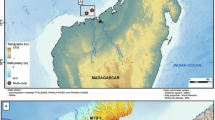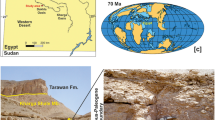Abstract
Environmentally sensitive benthic foraminifera (protists) from Chesapeake Bay were used as bioindicators to estimate the timing and degree of changes in dissolved oxygen (DO) over the past five centuries. Living foraminifers from 19 surface samples and fossil assemblages from 11 sediment cores dated by210Pb,137Cs,14C, and pollen stratigraphy were analyzed from the tidal portions of the Patuxent, Potomac, and Choptank Rivers and the main channel of the Chesapeake Bay.Ammonia parkinsoniana, a facultative anaerobe tolerant of periodic anoxic conditions, comprises an average of 74% of modern Chesapeake foraminiferal assemblages (DO-0.47 and 1.72 ml l−1) compared to 0% to 15% of assemblages collected in the 1960s. Paleoecological analyses show thatA. parkinsoniana was absent prior to the late 17th century, increased to 10–25% relative frequency between approximately 1670–1720 and 1810–1900, and became the dominant (60–90%) benthic formaniferal species in channel environments beginning in the early 1970s. Since the 1970s, deformed tests ofA. parkinsoniana occur in all cores (10–20% ofAmmonia), suggesting unprecedented stressful benthic conditions. These cores indicate that prior to the late 17th century, there was limited oxygen depletion. During the past 200 years, decadal scale variability in oxygen depletion has occurred, as dysoxic (DO=0.1–1.0 ml l−1), perhaps short-term anoxic (DO<0.1 ml l−1) conditions developed. The most extensive (spatially and temporally) anoxic conditions were reached during the 1970s. Over decadal timescales, DO variability seems to be linked closely to climatological factors influencing river discharge; the unprecedented anoxia since the early 1970s is attributed mainly to high freshwater flow and to an increase in nutrient concentrations from the watershed.
Similar content being viewed by others
Literature Cited
Alve, E. 1991a. Benthic foraminifera in sediment cores reflecting heavy metal pollution in Sorfjord, western Norway.Journal of Foraminiferal Research 21:1–19.
Alve, E. 1991b. Foraminifera, climatic change, and pollution: A study of late Holocene sediments in Drammensfjord, Southeast Norway.The Holocene 1:243–261.
Alve, E. andJ. W. Murray. 1995. Benthic foraminiferal distribution and abundance changes in Skagerrak surface sediments: 1937 (Hoglund) and 1992/1993 data compared.Marine Micropaleontology 25:269–288.
Bernhard, J. M. 1996. Microaerophilic and facultative anaerobic benthic foraminifera: A review of experimental and ultrastructural evidence.Revue de Paleobiologie 15:261–275.
Bernhard, J. M. in press. Distinguishing live from dead foraminifera: Methods review and proper applications.In J. J. Lee (ed.), Biology of Foraminifers. Volume II. Micropaleontology Press, New York.
Bernhard, J. M. andB. K. Sen Gupta. 1999. Foraminifera of oxygen-depleted environments, p. 201–216.In B. K. Sen Gupta (ed.), Modern Foraminifera. Kluwer Academic, Boston, Massachusetts.
Boynton, W. andM. Kemp. 1985. Nutrient regeneration and oxygen consumption by sediments along an estuarine salinity gradient.Marine Ecology Progress Series 23:45–55.
Boynton, W. R., J. H. Garber, R. Summers, andW. M. Kemp. 1995. Inputs, transformations, and transport of nitrogen and phosphorous in Chesapeake Bay and selected tributaries.Estuaries 18:285–314.
Bradshaw, J. S. 1957. Laboratory studies on the rate of growth of the foraminifer “Steblus beccarii” (Linne) var.tepida (Cushman).Journal of Paleontology 31:1138–1147.
Bradshaw, J. S. 1961. Laboratory experiments on the ecology of foraminifera.Cushman Foundation for Foraminiferal Research Contributions 12:87–106.
Brooks, A. L. 1967. Standing crop, vertical distribution, and morphometrics ofAmmonia beccaii (Linne).Limnology and Oceanography 12:667–684.
Brush, G. A. 1984. Stratigraphic evidence of eutrophication in an estuary.Water Resources Research 20:531–541.
Brush, G. S., E. A. Martin, R. S. DeFries, andC. A. Rice. 1982. Comparison of210Pb and pollen methods for determining rates of estuarine sediment accumulation.Quaternary Research 18:196–217.
Buzas, M. A. 1969. Foraminiferal species densities and environmental variables in an estuary.Limnology and Oceanography 14:411–422.
Buzas, M. A. 1974. Vertical distribution ofAmmobaculites in the Rhode River, Maryland.Journal of Foraminiferal Research 4:144–147.
Buzas, M. A. 1990. Another look at confidence limits for species proportions.Journal of Paleontology 64:842–843.
Cook, E. R. andG. C. Jacoby. 1983. Potomac River discharge since 1730 as reconstructed by tree rings.Journal of Climate and Applied Meteorology 22:1659–1672.
Cooper, S. R. 1995. Chesapeake Bay watershed historical land use: Impact on water quality and diatom communities.Ecological Applications 5:703–723.
Cooper, S. R. andG. S. Brush. 1991. Long-term history of Chesapeake Bay anoxia.Science 254:992–996.
Cooper, S. R. andG. S. Brush. 1993. A 2,500 year history of anoxia and eutrophication in Chesapeake Bay.Estuaries 16: 617–626.
Cornwell, J. C., D. J. Conley, M. Owens, andJ. C. Stephenson. 1996. A sediment chronology of the eutrophication of Chesapeake Bay.Estuaries 19:488–499.
Cronin, T. M., S. M. Colman, D. Willard, R. Kerhin, C. Holmes, andS. Phillips. 1999a. Research Examines Chesapeake Bay Sedimentary Record of Holocene Climatic Variability and Human Ecosystem Disturbance.EOS, Transactions, American Geophysical Union 80:23 and 240–241.
Cronin, T. M., R. S. Wagner, and M. Slattery (eds.). 1999b. Microfossils from Chesapeake Bay Sediments: Illustrations and Species Database, U.S. Geological Survey Open-file Report 99-45. Reston, Virginia.
Cronin, T. M., D. A. Willard, R. T. Kerhin, A. Karlsen, C. Holmes, S. E. Ishman, S. Verardo, J. McGeehin, S. Colman, andA. Zimmerman. 2000. Climatic variability in the eastern United States over the past millennium from Chesapeake Bay sediments.Geology 28:3–6.
Debenay, J.-P., E. Beneteau, J. Zhang, V. Stouff, E. Geslin, F. Redois, andM. Fernandez-Gonzalez. 1998.Ammonia beccarii andAmmonia tepida (foraminifera): Morphofunctional arguments for their distinction.Marine Micropaleontology 34:235–244.
Ellison, R. L. 1972. Ammobaculites, a foraminiferal proprietor of Chesapeake Bay estuaries.Geological Society of America Bulletin 133:247–262.
Ellison, R. L., R. Broome, andR. Ogilvie. 1986. Foraminiferal response to trace metal contamination in the Patapsco River and Baltimore Harbour, Maryland.Marine Pollution Bulletin 17:419–423.
Ellison, R. L. andM. M. Nichols. 1970. Ecology of foraminifera from the Rappahannock Estuary, Virginia.Cushman Foundation for Foraminiferal Research Contributions 21:1–17.
Ellison, R. L. and M. M. Nichols. 1976. Modern and Holocene foraminifera in the Chesapeake Bay region, p. 131–151.In C. T. Schafer and B. R. Pelletier (eds.), Ist International Symposium on Benthonic Foraminifera of Continental Margins, Part A. Maritime Sediments Special Publication 1. Halifax, Nova Scotia.
Ellison, R. L., M. M. Nichols, and J. Hughes. 1965. Distribution of Recent Foraminifera in the Rappahannock River Estuary, Virginia Institute of Marine Science Special Science Report No. 47:1–35. Gloucester Point, Virginia.
Fenchel, T., andB. J. Finlay. 1995. Ecology and Evolution in Anoxic Worlds, Oxford University Press, Oxford, England.
Flynn, W. W. 1968. The determination of low levels of polonium-210 in environmental materials.Analytica Chimica Acta 43: 221–227.
Geslin, E., J.-P. Debenay, andM. Lesourd. 1998. Abnormal wall textures and test deformation inAmmonia (hyaline foraminifera).Journal of Foraminiferal Research 28:148–156.
Goldberg, E. D., V. Hodge, M. Koide, J. Griffin, E. Gamble, O. P. Bricker, G. Matisoff, G. R. Holdren, Jr., andR. Braun. 1978. A pollution history of Chesapeake Bay.Geochimica et Cosmochimica Acta 42:1413–1425.
Gray, J. S. andM. I. Abdullah. 1996. Are there negative trends in oxygen saturation along the Norwegian Skagerrak coast?Limnology and Oceanography 41:810–812.
Holzmann, M. andJ. Pawlowski. 1997. Molecular, morphological and ecological evidence for species recognition inAmmonia (Foraminifera).Journal of Foraminiferal Research 27:311–318.
Holzmann, M., W. Piller, andJ. Pawlowski. 1996. Sequence variations in large-subunit ribosomal RNA gene of Ammonia (foraminifer, Protozoa) and their evolutionary implications.Journal of Molecular Evolution 43:145–151.
Jaworski, N. A., R. W. Howarth, andL. J. Hetling. 1997. Atmospheric deposition of nitrogen oxides onto the landscape contributes to coastal eutrophication in the northeast United States.Environmental Science and Technology 31:1995–2004.
Johannessen, T. andE. Dahl. 1996. Declines in oxygen concentrations along the Norwegian Skagerrak coast, 1927–1993: A signal of ecosystem changes due to eutrophication.Limnology and Oceanography 41:766–778.
Jorissen, E. J. 1988. Benthic foraminifera from the Adriatic Sea: Principles of phenotypic variation.Utrecht Micropaleontological Bulletin 37:7–139.
Kerhin, R. T., C. Williams, and T. M. Cronin. 1998. Lithologic Descriptions of Piston cores from Chesapeake Bay, Maryland. U.S. Geological Survey Open-File Report 98-787. Reston, Virginia.
Kitazato, H. 1994. Foraminiferal microhabitats in four marine environments around Japan.Marine Micropaleontology 24:29–41.
Malone, T. C. 1991. River flow, phytoplankton production and oxygen depletion in Chesapeake Bay, p. 83–93.In R. V. Tyson and T. H. Pearson (eds.), Modern and Ancient Continental Shelf Anoxia. Geological Society Special Paper 58. London.
Malone, T. C. 1992. Effects of water column processes on dissolved oxygen, nutrients, phytoplankton and zooplankton, p. 61–112.In D. E. Smith, M. Leffler, and G. Mackiernan (eds.). Oxygen Dynamics in the Chesapeake Bay. Maryland Sea Grant. College Park, Maryland.
Moodley, L. andC. Hess. 1992. Tolerance of infaunal benthic foraminifera for low and high oxygen concentrations.Biological Bulletin 183:94–98.
Nagy, J. andE. Alve. 1987. Temporal changes in foraminiferal faunas and impact of pollution in Sandebukta, Oslo Fjord.Marine Micropaleontology 12:109–128.
Najjar, R. 1999. The water balance of the Susquehanna River Basin and its response to climate change.Journal of Hydrology 219:7–19.
Newcombe, C. L. andW. A. Horne. 1938. Oxygen-poor waters of the Chesapeake Bay.Science 88:80–81.
Nichols, M. M. andW. Norton. 1969. Foraminiferal populations in coastal plain estuary.Palaeogeography, Palaeoclimatology, Palaeoecology 6:197–213.
Officer, C. B., R. B. Biggs, J. L. Taft, L. E. Cronin, M. A. Tyler, andW. R. Boynton. 1984. Chesapeake Bay anoxia: Origin, development, significance.Science 223:22–27.
Patterson, R. T. andE. Fishbein. 1989. Re-examination of the statistical methods used to determine the number of point counts needed for micropaleontological quantitative research.Journal of Paleontology 63:245–248.
Pawlowski, J., I. Bolivar, J. Farhni, andL. Zaninetti. 1995. DNA analysis of “Ammonia beccarii” morphotypes: One or more species?Marine Micropaleontology 26:171–178.
Poag, C. W. 1978. Paired foraminiferal ecophenotypes in Gulf Coast estuaries: Ecological and paleoecological implications.Transactions Gulf Coast Association of Geological Societies 28:395–421.
Rabalais, N. N., W. J. Weisman, andR. E. Turner, 1994. Comparison of continuous records of near-bottom dissolved oxygen from the hypoxia zone along the Louisiana coast.Estuaries 17:850–861.
Schnitker, D. 1974. Ecotypic variation ofAmmonia becarii (Linne).Journal of Foraminiferal Research 4:216–223.
Seliger, H. H. and J. A. Boggs. 1988. Long term pattern of anoxia in the Chesapeake Bay, p. 570–583.In M. P. Lynch and E. C. Krome (eds.), Understanding the Estuary: Advances in Chesapeake Bay Research. Chesapeake Research Consortium Publication No. 129. Baltimore, Maryland.
Seliger, H. H., J. A. Boggs, andW. H. Biggley. 1985. Catastrophic anoxia in the Chesapeake Bay in 1984.Science 228: 70–75.
Sen Gupta, B., R. E. Turner, andH. H. Rabalais. 1996. Seasonal oxygen depletion in continental-shelf waters of Louisiana: Historical record of benthic foraminifers.Geology 24:227–230.
Sharifi, A. R., I. W. Croudace, andR. L. Austin. 1991. Benthic foraminiferids as pollution indicators in Southampton water, southern England, U.K.Journal of Micropaleontology 10:109–113.
Stahle, D. W., M. K. Cleaveland, D. B. Blanton, M. D. Therrell, andD. A. Gay. 1998. The lost colony and Jamestown drought.Science 280:564–567.
Stuiver, M. andP. J. Reimer. 1993. Extended14C data base and revised CALIB 3.014C age calibration program.Radiocarbon 35:215–230.
Taft, J. L., W. R. Taylor, E. O. Hartwig, andR. Loftus. 1980. Seasonal oxygen depletion in Chesapeake Bay.Estuaries 3:242–247.
Tyler, M. A. 1986. Flow-induced variation in transport and deposition pathways in the Chesapeake Bay: The effect on phytoplankton dominance and anoxia, p. 161–175.In D. A. Wolfe (ed.), Estuarine Variability, Academic Press, Orlando.
Walton, W. R. andB. J. Sloan. 1990. The genus Ammonia (Brunnich, 1772): Its geographic distribution and morphologic variability.Journal of Foraminiferal Research 20:128–156.
Yanko, V., M. Ahmad, andM. Kaminski. 1998. Morphological deformities of benthic foraminiferal tests in response to pollution in heavy metals: Implications for pollution monitoring.Journal of Foraminiferal Research 28:177–200.
Yanko, V., J. Kronfeld, andA. Flexer. 1994. Response of benthic foraminifera to various pollution sources: Implications for pollution monitoring.Journal of Foraminiferal Research 24: 1–17.
Sources of Unpublished Materials
Kitazato, H. personal communication. Institute of Geosciences, Shizuoka University, Shizuoka 422 Japan.
Jaworski, N. personal communication. Retired from U.S. Environmental Protection Agency, Office of Research and Development, Narragansett, Rhode Island 02882.
Author information
Authors and Affiliations
Corresponding author
Additional information
Deceased.
Rights and permissions
About this article
Cite this article
Karlsen, A.W., Cronin, T.M., Ishman, S.E. et al. Historical trends in Chesapeake Bay dissolved oxygen based on benthic foraminifera from sediment cores. Estuaries 23, 488–508 (2000). https://doi.org/10.2307/1353141
Received:
Accepted:
Issue Date:
DOI: https://doi.org/10.2307/1353141




